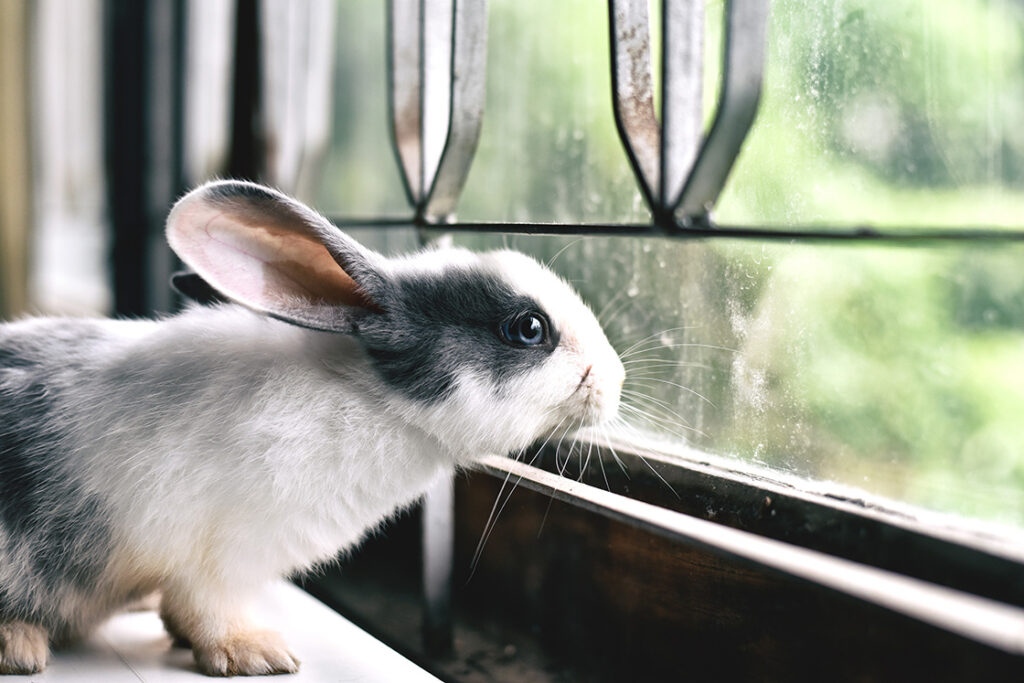Many house rabbit “parents” are curious to know what the world looks like to their lagomorph companion. Why does it seem difficult for my bunny to find food right in front of his face? Why is my bunny so easily startled or frightened if I walk into the room holding a box or a grocery bag? Can my rabbit see colors?
The first thing to remember is that a rabbit’s visual system evolved under evolutionary pressures completely different from those that “designed” your eyes. We human primates, like our simian cousins, have forward-placed eyes that confer binocular vision and depth perception. This is essential for an animal originally designed to leap through the trees. Also, we have excellent color vision, a trait that helped our ancestors to find ripe fruit and tasty flowers in the forest canopy.
On the other hand, the rabbit visual system is designed–not for foraging and locomotion–but to quickly and effectively detect approaching predators from almost any direction. The eyes are placed high and to the sides of the skull, allowing the rabbit to see nearly 360 degrees, as well as far above her head. Rabbits tend to be farsighted, which explains why they may be frightened by an airplane flying overhead even if their human companion can barely see it. (It could be a hawk! Run!)
The price the bunny pays for this remarkable field of vision is a small blind spot directly in front of his face, but forward-placed nostrils and large, spooning ears compensate for that minor loss of predator-detecting space. For an animal to have binocular vision, the field of view of both eyes must overlap to some degree. The central blind spot in the rabbit’s field of view precludes a three-dimensional view of nearby objects. When your bunny cocks her head and seems to be looking at you “sideways,” she is actually looking as straight at you as is possible for a bunny. As far as we know, she does not have a primate’s level of depth perception at such close range.
What about color vision? In general, vertebrates have two different types of photoreceptor cells in their retinas: rods and cones. Cones confer high resolution, and, if more than one cone type is present, they also confer the ability to perceive various wavelengths of light as distinct colors. For example, we humans have three different categories of cone–their maximum sensitivities in the red, blue and green regions of the spectrum. The differing sensitivities of each cone type enable us to perceive different (visible) wavelengths of light as the colors of the rainbow.
Behavioral studies published in the early 1970’s indicate that rabbits do have a limited ability to discriminate between some wavelengths of light, perceiving them as different colors. Evidently, they can discriminate between the wavelengths we call “green” and “blue.” Although rabbits may not perceive green and blue the way we do, they *can* tell them apart. This means they have limited color vision, probably conferred by two different categories of cone cells (blue and green).
The other type of photoreceptor, the rod cell, confers high visual sensitivity in low light situations, but relatively poor resolution (i.e., a “grainy” picture). The rabbit retina has a much higher ratio of rods to cones than the human retina has. Although a rabbit can see better than a human in low light conditions, his low light image has much poorer resolution (clarity) than the daytime images formed by your cone-rich, primate retina.
Now you may wonder: “Can my rabbit see me clearly, or am I just a big blur?” As you read this page, you are focusing on the letters with a very tiny part of your retina called the fovea. This is a minuscule, cone-shaped depression in the retina, lined wall-to-wall with high resolution cone cells.
Rabbits, too, have small retinal areas with more cones than rods. However, this area centralis is not indented, and it has far lower cone density than our fovea has. The image formed by the area centralis is relatively “grainy” compared to the one formed by your fovea, but it serves the rabbit well. Using this image, your voice, body movements and scent as cues, your rabbit can recognize you (his favorite human)–as long as you’re not carrying a scary box that completely changes your familiar shape!
Knowing a little more about how another creature sees the world allows us to come one step closer to understanding its behavior–and modifying our own to make life happier for everyone. Remember that the next time your rabbit gazes at you with those deep, ancient eyes.
©Copyright Dana Krempels. All Rights Reserved. Republished with the permission of the author.

